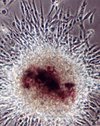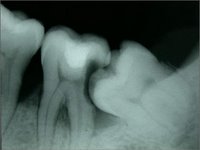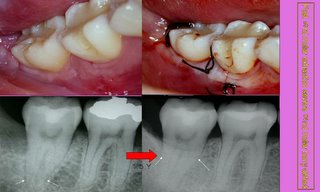TGF-Beta Signaling

What are your thoughts on the recent finding, released only last month, that the quality of bone matrix, a key component of bone, is regulated by a molecule known as transforming growth factor beta or TGF-Beta? The research may lead to improvements in the quality and speed of bone repair following dental implant placement or bone grafting.
For those who did not get a chance to read about the study, below is a brief sypnosis:
The ability of bone to resist damage depends on the mass, or quantity, of bone, its architecture and the quality of bone matrix, the mineralized material between cells. Several molecular factors have been shown to regulate the mass and architecture of bone. So far, however, none have been shown to regulate bone matrix, which is responsible for bone elasticity and toughness. There has been significant disagreement about whether the quality of bone matrix varies among individuals and, if it does, whether it could be altered for therapeutic reasons. In any case, until now, scientists have lacked a strategy for measuring its quality and teasing out its impact, says senior study author Tamara Alliston, PhD, UCSF assistant adjunct professor of Cell and Tissue Biology.
In the current study, the team explored whether transforming growth factor beta (TGF-ß) regulates the properties of bone matrix because there were hints that it might. TGF-ß is known to play a role in the development of osteoblasts, cells that produce bone matrix.
The researchers carried out their evaluation in five sets of mice genetically engineered to produce differing levels of TGF-ß signaling within osteoblasts, and, for comparison, in normal, or 'wild type' mice. After the animals had been euthanized, the team utilized highly sensitive instruments developed in the materials sciences -- atomic-force microscopy, x-ray tomography and micro-Raman spectroscopy -- to measure the properties of bone matrix independent of bone mass and architecture. They also compared the bones' resistance to fracture in a bending test.The results were notable, according to Alliston. In animals genetically engineered to produce high levels of TGF-ß, the measurements of bone matrix indicated increased susceptibility to fracture. The matrix was less elastic, less hard and contained lower levels of the mineral calcium phosphate. In addition, the animals' bones were less resistant to fracture in the bending test.In contrast, in animals with low levels of TGF-ß the bone matrix was more elastic, harder, had higher mineral concentration and the bone overall had increased mass. In addition, the bones were more resistant to fracture in the bending test.The bones studied included the femur, tibia and calvarial parietal bones."This is the first evidence that properties of bone matrix can be regulated by a growth factor and that by modifying the TGF-ß pathway, specifically, these properties can be controlled," says Alliston.The study suggests, she says, that TGF-ß could be targeted for clinical intervention in patients. "By decreasing TGF-ß signaling at the relevant site in the body, we may be able to improve the quality of bone to either prevent the damage that occurs in osteoarthritis and osteoporosis, or improve the quality and speed of bone repair following bone fracture, joint implantation, dental implants or bone grafting.""If we could decrease the production of TGF-ß at the site of the transplant, we might be able to strengthen the quality of bone being formed," says the lead author of the study, Guive Balooch, BA, in the UCSF Graduate Program in Oral and Craniofacial Sciences and Division of Bioengineering.
Source: http://pub.ucsf.edu/newsservices/releases/200512136/




